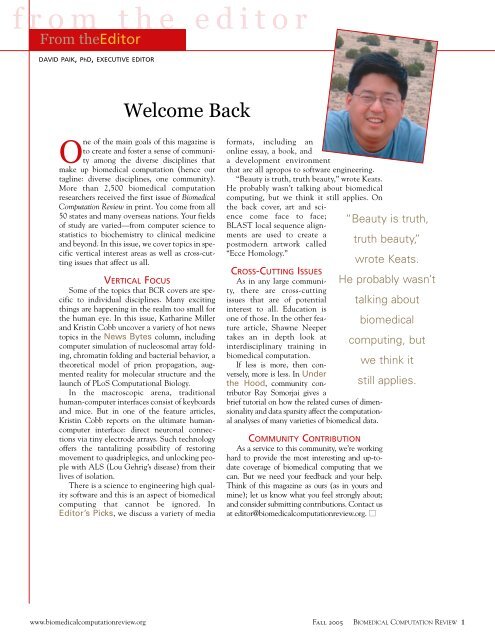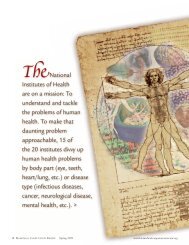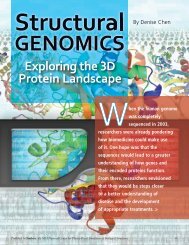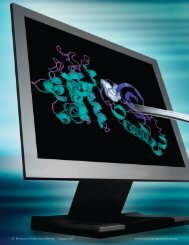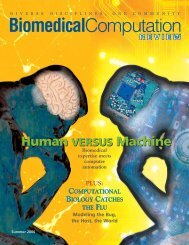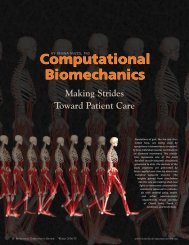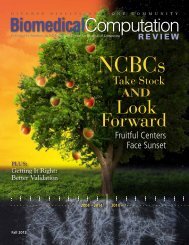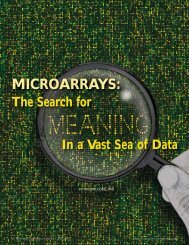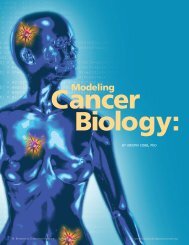here - Biomedical Computation Review
here - Biomedical Computation Review
here - Biomedical Computation Review
Create successful ePaper yourself
Turn your PDF publications into a flip-book with our unique Google optimized e-Paper software.
from the editorFrom theEditorDAVID PAIK, PhD, EXECUTIVE EDITORWelcome BackOne of the main goals of this magazine isto create and foster a sense of communityamong the diverse disciplines thatmake up biomedical computation (hence ourtagline: diverse disciplines, one community).More than 2,500 biomedical computationresearchers received the first issue of <strong>Biomedical</strong><strong>Computation</strong> <strong>Review</strong> in print. You come from all50 states and many overseas nations. Your fieldsof study are varied—from computer science tostatistics to biochemistry to clinical medicineand beyond. In this issue, we cover topics in specificvertical interest areas as well as cross-cuttingissues that affect us all.VERTICAL FOCUSSome of the topics that BCR covers are specificto individual disciplines. Many excitingthings are happening in the realm too small forthe human eye. In this issue, Katharine Millerand Kristin Cobb uncover a variety of hot newstopics in the News Bytes column, includingcomputer simulation of nucleosomal array folding,chromatin folding and bacterial behavior, atheoretical model of prion propagation, augmentedreality for molecular structure and thelaunch of PLoS <strong>Computation</strong>al Biology.In the macroscopic arena, traditionalhuman-computer interfaces consist of keyboardsand mice. But in one of the feature articles,Kristin Cobb reports on the ultimate humancomputerinterface: direct neuronal connectionsvia tiny electrode arrays. Such technologyoffers the tantalizing possibility of restoringmovement to quadriplegics, and unlocking peoplewith ALS (Lou Gehrig’s disease) from theirlives of isolation.T<strong>here</strong> is a science to engineering high qualitysoftware and this is an aspect of biomedicalcomputing that cannot be ignored. InEditor’s Picks, we discuss a variety of mediaformats, including anonline essay, a book, anda development environmentthat are all apropos to software engineering.“Beauty is truth, truth beauty,” wrote Keats.He probably wasn’t talking about biomedicalcomputing, but we think it still applies. Onthe back cover, art and sciencecome face to face;BLAST local sequence alignmentsare used to create apostmodern artwork called“Ecce Homology.”CROSS-CUTTING ISSUESAs in any large community,t<strong>here</strong> are cross-cuttingissues that are of potentialinterest to all. Education isone of those. In the other featurearticle, Shawne Neepertakes an in depth look atinterdisciplinary training inbiomedical computation.If less is more, then conversely,more is less. In Underthe Hood, community contributorRay Somorjai gives abrief tutorial on how the related curses of dimensionalityand data sparsity affect the computationalanalyses of many varieties of biomedical data.COMMUNITY CONTRIBUTIONAs a service to this community, we’re workinghard to provide the most interesting and up-todatecoverage of biomedical computing that wecan. But we need your feedback and your help.Think of this magazine as ours (as in yours andmine); let us know what you feel strongly about;and consider submitting contributions. Contact usat editor@biomedicalcomputationreview.org. ■“Beauty is truth,truth beauty,”wrote Keats.He probably wasn’ttalking aboutbiomedicalcomputing, butwe think itstill applies.www.biomedicalcomputationreview.orgFall 2005 BIOMEDICAL COMPUTATION REVIEW 1


